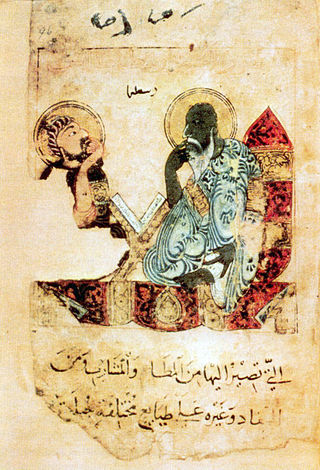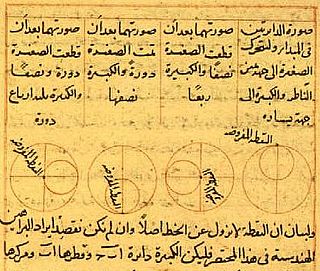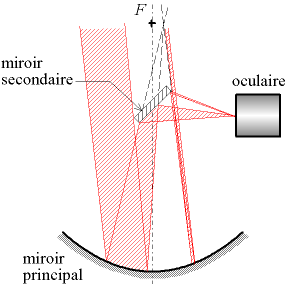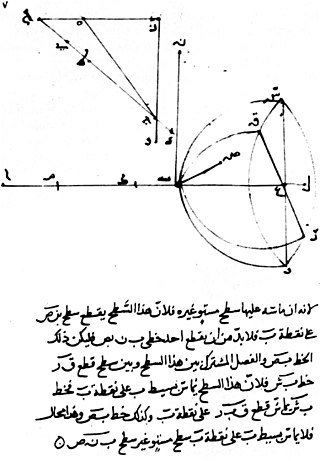
Ḥasan Ibn al-Haytham was a medieval mathematician, astronomer, and physicist of the Islamic Golden Age from present-day Iraq. Referred to as "the father of modern optics", he made significant contributions to the principles of optics and visual perception in particular. His most influential work is titled Kitāb al-Manāẓir, written during 1011–1021, which survived in a Latin edition. The works of Alhazen were frequently cited during the scientific revolution by Isaac Newton, Johannes Kepler, Christiaan Huygens, and Galileo Galilei.

Islamic philosophy is philosophy that emerges from the Islamic tradition. Two terms traditionally used in the Islamic world are sometimes translated as philosophy—falsafa, which refers to philosophy as well as logic, mathematics, and physics; and Kalam, which refers to a rationalist form of Scholastic Islamic theology which includes the schools of Maturidiyah, Ashaira and Mu'tazila.
Early Islamic philosophy or classical Islamic philosophy is a period of intense philosophical development beginning in the 2nd century AH of the Islamic calendar and lasting until the 6th century AH. The period is known as the Islamic Golden Age, and the achievements of this period had a crucial influence in the development of modern philosophy and science. For Renaissance Europe, "Muslim maritime, agricultural, and technological innovations, as well as much East Asian technology via the Muslim world, made their way to western Europe in one of the largest technology transfers in world history.” This period starts with al-Kindi in the 9th century and ends with Averroes at the end of 12th century. The death of Averroes effectively marks the end of a particular discipline of Islamic philosophy usually called the Peripatetic Arabic School, and philosophical activity declined significantly in Western Islamic countries, namely in Islamic Spain and North Africa, though it persisted for much longer in the Eastern countries, in particular Persia and India where several schools of philosophy continued to flourish: Avicennism, Illuminationist philosophy, Mystical philosophy, and Transcendent theosophy.

Science in the medieval Islamic world was the science developed and practised during the Islamic Golden Age under the Umayyads of Córdoba, the Abbadids of Seville, the Samanids, the Ziyarids, the Buyids in Persia, the Abbasid Caliphate and beyond, spanning the period roughly between 786 and 1258. Islamic scientific achievements encompassed a wide range of subject areas, especially astronomy, mathematics, and medicine. Other subjects of scientific inquiry included alchemy and chemistry, botany and agronomy, geography and cartography, ophthalmology, pharmacology, physics, and zoology.

Kamal al-Din Hasan ibn Ali ibn Hasan al-Farisi or Abu Hasan Muhammad ibn Hasan ) was a Persian Muslim scientist. He made two major contributions to science, one on optics, the other on number theory. Farisi was a pupil of the astronomer and mathematician Qutb al-Din al-Shirazi, who in turn was a pupil of Nasir al-Din Tusi.

Catoptrics deals with the phenomena of reflected light and image-forming optical systems using mirrors. A catoptric system is also called a catopter (catoptre).

Ibn Sahl was a Persian mathematician and physicist of the Islamic Golden Age, associated with the Buyid court of Baghdad. Nothing in his name allows us to glimpse his country of origin.
Shams al-Dīn Muḥammad ibn Ashraf al-Ḥusaynī al-Samarqandī was a 13th century Persian astronomer and mathematician from Samarkand, now in Uzbekistan.
Abdelhamid Ibrahim Sabra (1924-2013) was a professor of the history of science specializing in the history of optics and science in medieval Islam. He died December 18, 2013. Sabra provided English translation and commentary for Books I-III of Ibn al-Haytham's seven book Kitab al-Manazir, written in Arabic in the 11th century.
Islamic cosmology is the cosmology of Islamic societies. It is mainly derived from the Qur'an, Hadith, Sunnah, and current Islamic as well as other pre-Islamic sources. The Qur'an itself mentions seven heavens.

The Book of Optics is a seven-volume treatise on optics and other fields of study composed by the medieval Arab scholar Ibn al-Haytham, known in the West as Alhazen or Alhacen.
The natural sciences saw various advancements during the Golden Age of Islam, adding a number of innovations to the Transmission of the Classics. During this period, Islamic theology was encouraging of thinkers to find knowledge. Thinkers from this period included Al-Farabi, Abu Bishr Matta, Ibn Sina, al-Hassan Ibn al-Haytham and Ibn Bajjah. These works and the important commentaries on them were the wellspring of science during the medieval period. They were translated into Arabic, the lingua franca of this period.

Alhazen's problem, also known as Alhazen's billiard problem, is a mathematical problem in geometrical optics first formulated by Ptolemy in 150 AD. It is named for the 11th-century Arab mathematician Alhazen who presented a geometric solution in his Book of Optics. The algebraic solution involves quartic equations and was found in 1965 by Jack M. Elkin.
Haytham, Haitham or Haitem is a male Semitic given name with Ancient Aramaic origins meaning "young eagle" or "young hawk". It is highly popular among Middle Eastern communities from different backgrounds, including Arabs, Jews and Assyrians, as well as Copts, and Berbers. The name is used by Jews, Christians and Muslims alike.
Lashkar Haytham ibn Khalid was the first Shirvanshah, or independent ruler of Shirvan, renouncing the suzerainty of the Abbasid Caliphate in 861 and beginning the Mazyadid dynasty.
Roshdi Rashed, born in Cairo in 1936, is a mathematician, philosopher and historian of science, whose work focuses largely on mathematics and physics of the medieval Arab world. His work explores and illuminates the unrecognized Arab scientific tradition, being one of the first historians to study in detail the ancient and medieval texts, their journey through the Eastern schools and courses, their immense contributions to Western science, particularly in regarding the development of algebra and the first formalization of physics.

Ahmed Salim is a British social entrepreneur and producer of transmedia productions including films, international exhibitions, live shows, books and educational and social campaigns that have engaged more than 450 million people around the world. Ahmed Salim is on The 500 Most Influential Muslims lists of 2015, 2016, 2017 and 2018.
Alhazen was an 11th-century Arab mathematician and astronomer. "Alhazen" may also refer to:








